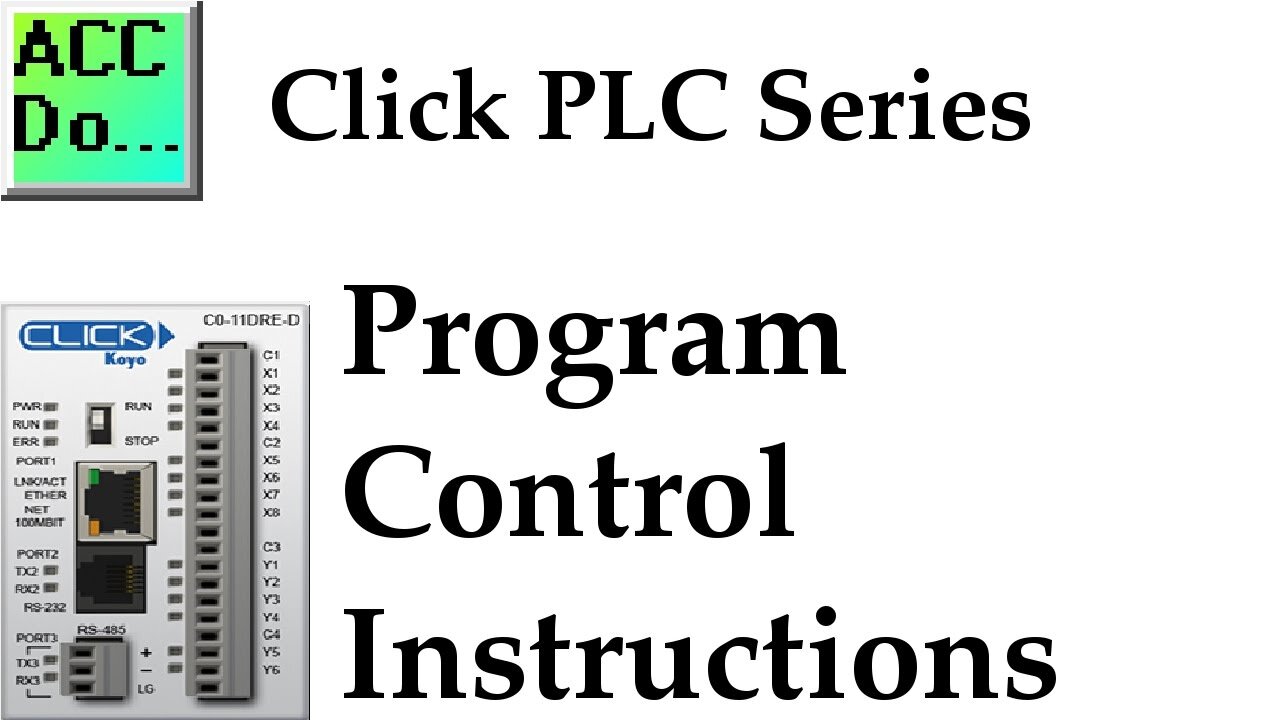Premium Only Content

Click PLC Program Control Instructions
We will now look at the click plc program control instructions available to you.
The program control instructions will allow us to specify what parts of the logic get solved and when this happens. This will control how the PLC will scan and solve your logic in your program.
Program control (flow) instructions in the Click PLC will utilize interrupts and subroutines. In the last post on Click PLC Compare and Math Instructions, we discussed interrupts. They can be timed or event (Built-in inputs on the CPU.) When the interrupt happens it will immediately go and solve the logic in the interrupt and then return to the instruction following the location that it was called. This can and will happen at any time throughout the scan of the PLC.
More information can be obtained on our website. This includes all of the links mentioned in this video.
https://accautomation.ca/click-plc-program-control-instructions
00:00 Click PLC program control
00:23 Click PLC Interrupts
01:45 Interrupt Setup
02:35 Click PLC Subroutines
03:12 Calling subroutines - Main PLC
04:33 Testing our PLC Program Control
Previously we discussed:
Click PLC System-Hardware.
https://accautomation.ca/click-plc-system-hardware/
Click PLC Installing the Software
https://accautomation.ca/click-plc-installing-the-software/
Click PLC Establish Communication
https://accautomation.ca/click-plc-establish-communication/
Click PLC Numbering System and Addressing
https://accautomation.ca/click-plc-numbering-system-and-addressing
Click PLC Timers and Counters
https://accautomation.ca/click-plc-timers-and-counters
Click PLC Compare and Math Instructions
https://accautomation.ca/click-plc-compare-and-math-instructions
Download the Click Programming software at the following address:
https://support.automationdirect.com/products/clickplcs.html
There are several reasons why we are using the Click PLC. Here are just a few.
- Investment is low for the hardware and the software is free
- Standalone PLC with built-in I/O
- Communication ability - Ethernet Port, RS232, RS485 - support for protocols such as Modbus RTU, Modbus TCP, etc.
- Ability to expand the system with a variety of modules including RTD and Thermocouple inputs directly.
-
 2:37:49
2:37:49
Badlands Media
23 hours agoDevolution Power Hour Ep. 346
98K21 -
 2:43:21
2:43:21
TimcastIRL
7 hours agoDemocrat DEFENSE Of MS-13 Member BLOWS UP In Their FACE, Trump Admin DROPS PROOF | Timcast IRL
195K142 -
 2:08:15
2:08:15
Adam Carolla
3 days ago $15.77 earnedDolph Lundgren on Beating Cancer, Sahil Bloom Talks 5 Types of Wealth & Gen-Z’s Minecraft Madness
55.3K9 -
 3:59:22
3:59:22
Alex Zedra
6 hours agoLIVE! Scary Games Girls Night
41.6K5 -
 4:25:26
4:25:26
Drew Hernandez
13 hours agoKARMELO ANTHONY FAM BUYS NEW CAR, BIG LETICIA IS SHOOK & EL SALVADOR ILLEGAL IS A WIFE BEATER?
83.3K23 -
 1:15:02
1:15:02
Man in America
13 hours agoTHE GREAT TAKING: They’re Coming for YOUR Assets—the Sinister Plan Exposed w/ James Patrick
55.3K18 -
 1:55:55
1:55:55
Amish Zaku
7 hours agoCall in Creations EP# 10 Featuring GamerGril
35.4K -
 1:11:52
1:11:52
Omar Elattar
12 hours agoThe Ex-Marine Millionaire: "How I Turned My $26K in Savings to $70M at 35!"
53.7K6 -
 3:15:44
3:15:44
I_Came_With_Fire_Podcast
16 hours agoChina Trade War | Driving Miss Perry | German Court
52K7 -
 1:37:07
1:37:07
Glenn Greenwald
8 hours agoAre We Moving Towards War With Iran? PLUS: Zaid Jilani on the El Salvador Deportations and Harvard’s Fight Against Trump | SYSTEM UPDATE #440
126K83